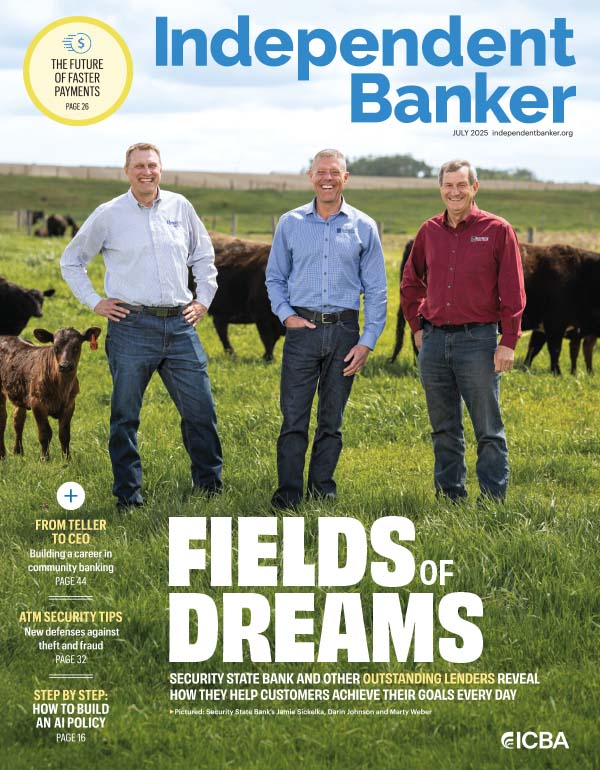We’ve made it, you and I, through a bizarre year. No more “2020 vision” references, no national elections and—hopefully—no moratoria on business travel. But there’s plenty of the recent past for community bankers to still contend with.
As we begin the calendar year, I would think one of the top to-dos on the lists of bond portfolio managers is to wrestle with the swollen collection of investments that began arriving in March 2020 to ascertain whether it’s built out to your liking. If so, maybe you now have a blueprint to continue to invest and tweak in a manner that complements your community bank’s balance sheet and risk profile.
If not, opportunities proliferate. This time last year, I suggested that we may be in for some interest rate stability. (We see how that turned out.) This time around, let’s say that if there is some rate stability, and some bond swapping is in your best interest, it’s possible that all the benefits to a well-structured trade can be realized and any income effect having nearly a full year to be recognized. The remainder of this column will discuss this and other strategies that are on the table for portfolio management.
Cushion paper galore
Whether you realize it or not, your bank’s bond portfolio already has a floating-rate tenor to it, partly thanks to the record-low interest rates we’ve had lately. As of year-end, the average bond owned by a community bank has a book price of almost 103. And that means that if rates ever get around to increasing noticeably, your yields will automatically, magically, increase, too.
This presumes that the bonds in a portfolio have some optionality. That means they can prepay at the borrower’s discretion. They include bonds both with explicit call options, as in the case of a callable agency, and those with implicit options, as in the case of a mortgage-backed security (MBS). It’s a pretty good bet that your portfolio is short these options, since well more than 80% of the bonds at a community bank has some kind of callability. It’s common for a broker or a consultant to produce a report that calculates the prospective yields in their clients’ portfolios given a change in rates.
Bear steepener ahead?
The latter months of 2020 saw the long end of the curve test some technical support levels. After averaging around 70 basis points (0.7%) from April through November, the 10-year note reached more than 1% in November, while shorter yields remained anchored by the Fed’s words and deeds. The result was a Treasury yield curve that was the steepest since early 2018. This may be viewed as an opportunity to buy “out on the curve,” as certain maturities are now noticeably cheaper than at anytime since the pandemic took over our bond portfolios.
Recall, too, that many community banks are now exposed to falling rates. Therefore, those institutions can cut their rate risk by locking up some yield on the longer end. And this steepening has taken place during a period in which the Fed has signaled no change in its commitment to keeping rates low for an extended period of time. All of these factors build a plausible case for selling shorter duration investments and tactically extending average lives.
No free lunch
This rise in available yields should be taken in context. We are still in an environment that is historically low and a yield curve that is historically flat. And, with all the deficit spending we did in the past year, at some point one would think that the supply of Federal debt could start to weigh on bond prices. Investors in Treasury securities continue to earn negative real rates.
Nonetheless, the start of the year is a great time to consider a bond swap. This year, most bonds have unrealized gains, so the test isn’t going to be how quickly a loss will be made up; it will be how much incremental income will be earned through the average life of the bonds that are sold. This will also require some careful analysis, because it’s possible—if not likely—that the “new” bonds will have lower yields than the “old” ones.
This brings up another factor to consider: the timing of the recognition of income. Most tax accountants would recommend that tax liability be delayed, not accelerated. One way to deal with this is to sell a combination of bonds at a net breakeven or a net loss. Also, recall that the least advantageous sector to take gains is tax-free municipals. Concentrate first on taxables.
So, the next phase of portfolio management for community banks has some potential: lots of liquidity, higher rates, a steeper curve and most of a calendar year to benefit from a bond swap. Also, no suggestion from your columnist about rate stability in 2021.
Education on Tap
Vining Sparks, ICBA Securities’ exclusive broker, will once again host quarterly webinars that discuss the state of the economy and interest rate trends. Economists Craig Dismuke and Dudley Carter will kick off the series on Jan. 12 at 10 a.m. Central. Visit viningsparks.com to register.






